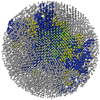+Search query
-Structure paper
| Title | A mechanism for histone chaperoning activity of nucleoplasmin: thermodynamic and structural models. |
|---|---|
| Journal, issue, pages | J Mol Biol, Vol. 393, Issue 2, Page 448-463, Year 2009 |
| Publish date | Oct 23, 2009 |
 Authors Authors | Stefka G Taneva / Sonia Bañuelos / Jorge Falces / Igor Arregi / Arturo Muga / Petr V Konarev / Dmitri I Svergun / Adrián Velázquez-Campoy / María A Urbaneja /  |
| PubMed Abstract | Nucleoplasmin (NP), a histone chaperone, acts as a reservoir for histones H2A-H2B in Xenopus laevis eggs and can displace sperm nuclear basic proteins and linker histones from the chromatin fiber of ...Nucleoplasmin (NP), a histone chaperone, acts as a reservoir for histones H2A-H2B in Xenopus laevis eggs and can displace sperm nuclear basic proteins and linker histones from the chromatin fiber of sperm and quiescent somatic nuclei. NP has been proposed to mediate the dynamic exchange of histones during the expression of certain genes and assists the assembly of nucleosomes by modulating the interaction between histones and DNA. Here, solution structural models of full-length NP and NP complexes with the functionally distinct nucleosomal core and linker histones are presented for the first time, providing a picture of the physical interactions between the nucleosomal and linker histones with NP core and tail domains. Small-angle X-ray scattering and isothermal titration calorimetry reveal that NP pentamer can accommodate five histones, either H2A-H2B dimers or H5, and that NP core and tail domains are intimately involved in the association with histones. The analysis of the binding events, employing a site-specific cooperative model, reveals a negative cooperativity-based regulatory mechanism for the linker histone/nucleosomal histone exchange. The two histone types bind with drastically different intrinsic affinity, and the strongest affinity is observed for the NP variant that mimicks the hyperphosphorylated active protein. The different "affinity windows" for H5 and H2A-H2B might allow NP to fulfill its histone chaperone role, simultaneously acting as a reservoir for the core histones and a chromatin decondensing factor. Our data are compatible with the previously proposed model where NP facilitates nucleosome assembly by removing the linker histones and depositing H2A-H2B dimers onto DNA. |
 External links External links |  J Mol Biol / J Mol Biol /  PubMed:19683001 PubMed:19683001 |
| Methods | SAS (X-ray synchrotron) |
| Structure data |  SASDA55:  SASDA65:  SASDA75: |
| Source |
|
 Movie
Movie Controller
Controller Structure viewers
Structure viewers About Yorodumi Papers
About Yorodumi Papers




